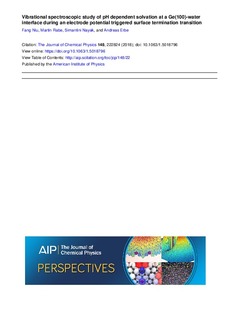| dc.description.abstract | The charge-dependent structure of interfacial water at the n-Ge(100)-aqueous perchlorate interface was studied by controlling the electrode potential. Specifically, a joint attenuated total reflection infrared spectroscopy and electrochemical experiment was used in 0.1M NaClO4 at pH ≈ 1–10. The germanium surface transformation to an H-terminated surface followed the thermodynamic Nernstian pH dependence and was observed throughout the entire pH range. A singular value decomposition-based spectra deconvolution technique coupled to a sigmoidal transition model for the potential dependence of the main components in the spectra shows the surface transformation to be a two-stage process. The first stage was observed together with the first appearance of Ge–H stretching modes in the spectra and is attributed to the formation of a mixed surface termination. This transition was reversible. The second stage occurs at potentials ≈0.1–0.3 V negative of the first one, shows a hysteresis in potential, and is attributed to the formation of a surface with maximum Ge–H coverage. During the surface transformation, the surface becomes hydrophobic, and an effective desolvation layer, a “hydrophobic gap,” developed with a thickness ≈1–3 Å. The largest thickness was observed near neutral pH. Interfacial water IR spectra show a loss of strongly hydrogen-bound water molecules compared to bulk water after the surface transformation, and the appearance of “free,” non-hydrogen bound OH groups, throughout the entire pH range. Near neutral pH at negative electrode potentials, large changes at wavenumbers below 1000 cm−1 were observed. Librational modes of water contribute to the observed changes, indicating large changes in the water structure. | nb_NO |
